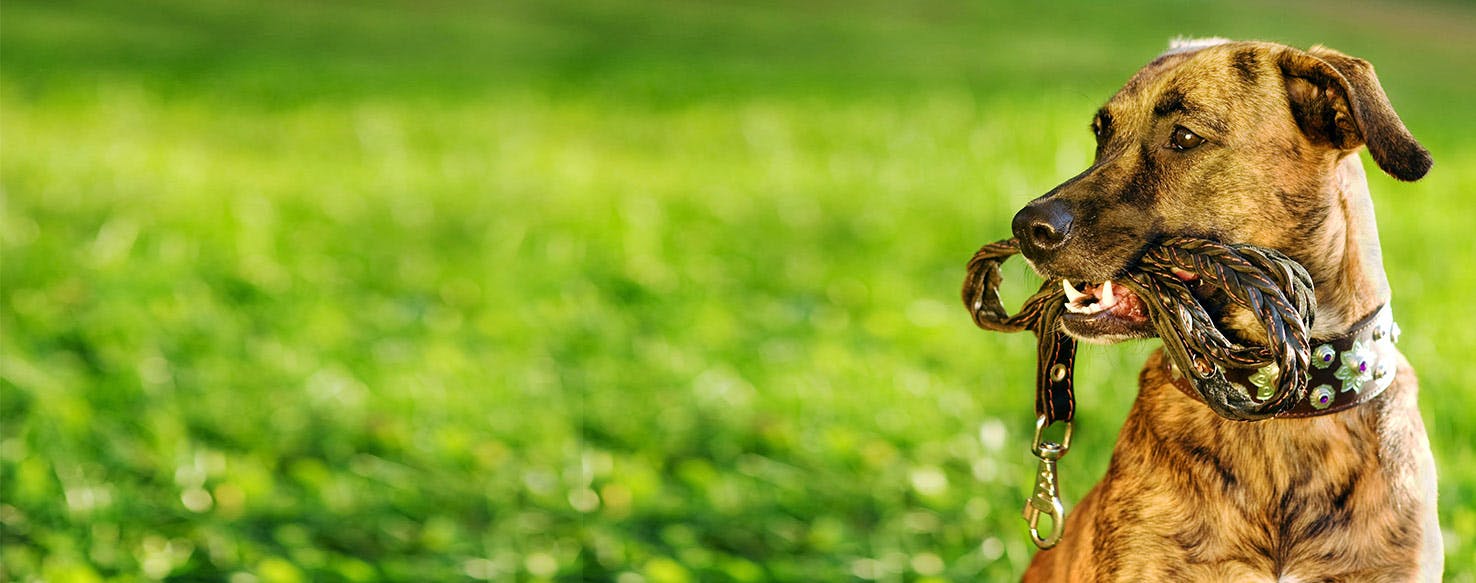- Home
- The Daily Wag!
- Behavior
- Why Do Dogs Put Their Leash In Their Mouth

Common
Irregular
Even if you are a first-time dog owner, you know that you are supposed to be the one holding the leash while your dog walks on the other end. So why does your dog feel the need to take the leash in his or her own mouth when the two of you hit the streets? A clue to the answer often lies in what the dog does with the leash once he or she has it. Some dogs will simply mouth at the leash, while others pull at it in an effort to change walk time into play time. In either case, the way your dog interacts with the leash indicates what his or her needs are at that particular point in time.
If your furry leash-grabber is still a puppy, the behavior may simply be a manifestation of his or her natural instinct to chew. Puppies mouth anything that they can reach, and things that move are particularly appealing. The more the leash bounces in your hand, the more the puppy wants to play with it. Your puppy may also be expressing frustration with the leash, which he or she perceives as restrictive of free movement. Instead of running around and exploring the environment, your puppy is forced to walk slowly and carefully. So, just like a child jumping out of his or her seat at school, your puppy pulls at the leash in an effort to be free. Older dogs may also mouth or tug on their leashes in an effort to exert control or to rebel against restrictions. They may be looking to play as well, although the desired end result may be slightly different than it is in the case of puppies. An older dog is less likely to mouth things for its own sake, and more likely to try to engage the owner in a game of tug-of-war.
Many owners unwittingly reinforce this behavior by trying to pull the leash back from the dog when he or she goes for it. While this seems like a correction to the human on the other end of the leash, the dog sees it as the owner going along with the game. The next time the dog gets bored on a walk, he or she is apt to try the same technique. If your dog is not tugging on the leash but is simply placing it in his or her mouth and leaving it there, play may not be the goal. Instead, the dog could be trying to comfort himself or herself in a stressful situation. This is particularly likely in the case of retriever breeds such as Labradors, who often feel most comfortable with something in their mouths.
Need advice about your pet's health?
Get answers fast from a veterinary professional 24/7 in the Wag! App.
Get Vet ChatWhether your dog is pulling on the leash or just chewing on it, you may want to keep it out of his or her mouth during walk time, if only to keep from engaging in a battle for control. The most important thing is not to reinforce the behavior, and this means not trying to pull the leash out of your dog's mouth by force. To do so is not to punish your dog, but to make him feel like the two of you are enjoying some quality time tearing apart an animal carcass. So, how do you get the leash out of your dog's mouth without pulling? One effective technique is to put your foot on the leash about six inches away from the part that is in his mouth. This will pull the dog's muzzle close enough to the floor that he or she will feel uncomfortable and let go.
You may not want to depend on this technique every time your dog goes for the leash, so it may be worth your while to train your dog on the “drop it” command. Every time the command is successful, give your dog a treat. If you are fairly certain that he is biting the leash because he wants to play tug, offer him a tug toy when he puts the leash down. That way, the dog will learn that letting go of the leash means he will get your attention in a positive way. If your dog is just mouthing the leash, or holding it without any force, he or she may need an alternative comfort object. A favorite stuffed toy can be an ideal choice, but anything that makes your dog feel calm and is portable should work.
Training your dog out of any behavior does take time, and you may need to have some patience as your dog gets used to not putting the leash in his or her mouth. Experts suggest the temporary use of a metal leash, such as the kind used on a choke chain. Be careful not to actually use the choke collar but only the leash, which is harder for a dog to grab. You may also need to spend some extra time playing with your dog to work out those tugging instincts. This can help to keep him or her from wanting to pull on the leash, but it is also an enjoyable bonding experience that both of you might want to continue once the leash-biting is past.
Your dog's bark may be worse than his (or her) bite, but you still do not want any leash biting as part of your daily routine. Not only does it slow your walk down, but it challenges your role as alpha. Take the time to gently discourage and replace the behavior, and you will find that time with your dog once again becomes a walk in the park!
Written by a Labrador Retriever lover Laura DeCesare
Veterinary reviewed by:
Published: 03/08/2018, edited: 01/30/2020
More articles by Laura DeCesare
